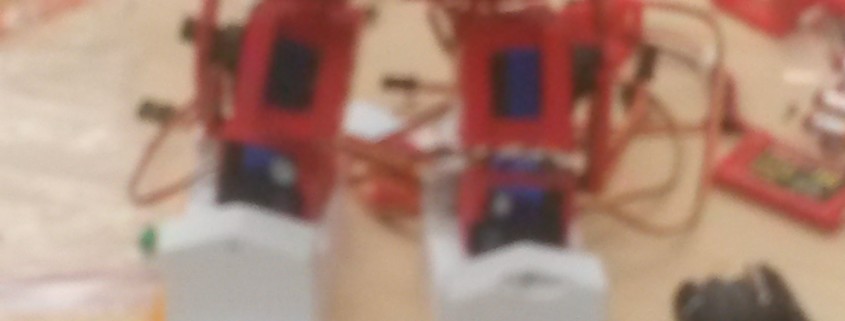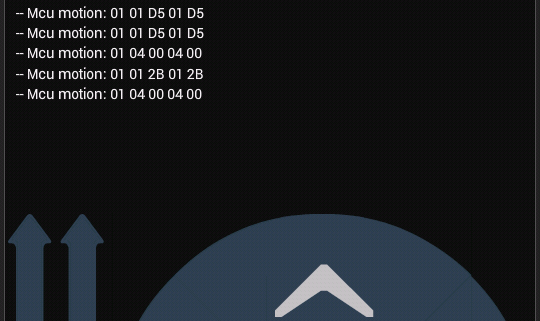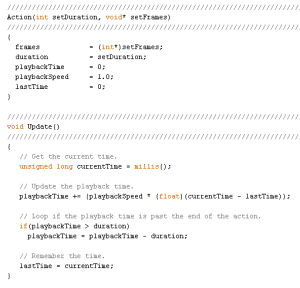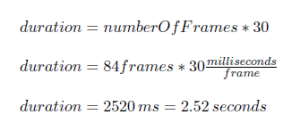Archive for category: Biped Generation #1
Micro BiPed Introduction
/in Biped, Biped Generation #1/by tatemcgearyMission Objective:
The project mission is inspired by the BiPed designed by Jonathan Dowdall of Project Biped, completed in previous semesters of EE 400D. The goal is to scale down the BiPed design by changing standard servos to micro servos to yield the μBiPed, which will result in design changes to the robot. The robot must be able to communicate and be controlled by the Axterra™ application. The final deliverable of this project is to have the µBiPed maneuver through an obstacle course, while being able to resist outside disturbances. The course may include multiple surfaces, an incline, and an obstacle avoidance portion; however, the challenges in the obstacle course may change.
Mission Profile:
The μBiPed must complete an obstacle course on a figure 8 track in ~ 7 minutes. The obstacle course will require the μBiPed to cross over a threshold, at approximately a 45° angle and a 2 cm height. From there the μBiPed must ascend an incline that is initially an 8° slope which then decreases to a 6° slope. Half way through the course the μBiPed must then start its descent down the incline towards the threshold again crossing over it at about a 45° angle proceeding towards its start position until an object (i.e. a wall) causes the μBiPed modify its path. Additionally the μBiPed must be able to withstand external disturbances. Finally the μBiPed must be able to traverse multiple types of surfaces which will include carpet, linoleum tile, and metal. All of this must be completed while using the Arxterra™ interface as per requirements. It has also been specified that microServos must be used.

*The above diagram was created in AUTOCAD™ 2014.
*Measurements were provided by the microSegway group, and confirmed by the microBiPed group.
Spring 2014 Biped Final Thoughts
/in Biped, Biped Generation #1, Communites, Members and Communities/by arxterraBy Kevin Huynh, Project Manager
Tasks Complete:
Alternative movement code to the one provided by projectbiped and robot poser. Alternate code includes statically stable forward walk, left turn, right turn, and obstacle avoidance code.
Remote control of ROFIA through Arxterra. ROFIA can be commanded to stand up straight, walk forward, turn left, and turn right.
Servo overcurrent protection using polyfuses.
Ideas for future classes:
Develop the ability to walk backward or to walk sideways. Add these abilities to the Arxterra control panel along with options to move the head servos.
Consider using lower torque servos for joints that do not need to rotate as much weight to minimize current consumption. For example, look at how ROFI has the higher torque servos (Power HD 1501) to control the hip, upper leg and middle legs and lower torque servos (Towerpro MG99R) to control the
knee, lower legs, and ankles.
Look into implementing an IMU board into ROFIA for active control and the ability to react to external forces.
Minimize the mass unbalance caused by the USB cable from the phone to the Arduino.
Find a way to monitor the voltage of the LiPo batteries for safety purposes.
Biped Movement Codes
/in Biped, Biped Generation #1, Communites, Members and Communities/by arxterraBy Kevin Huynh, Project Manager / Computer Systems and Software
Objective:
This blog will focus on the ideas behind how the code from projectbiped and the code from Spring 2014 handle the animation playback for walking and turning. It will also go into the reason for the switch.
ProjectBiped Code :
The most recent code can be found here:
http://www.projectbiped.com/prototypes/rofi/programs/arduino-action-playback
The code on project biped uses a timing system for the playback of the robot’s walking animation. The Action class holds all of the code for this movement method.
The timing system starts with the function Update, which calculates playbackTime with the variables currentTime, lastTime, playbackSpeed, and duration. The currentTime variable is determined by the Arduino command millis() which returns the number of milliseconds since the microcontroller began running the program. The lastTime variable is equal to the previous currentTime value from the last time the walking animation frame was updated.
The playbackSpeed is determined by the user, based on the speed they chose when creating action frames with in RobotPoser. The calculation value is assigned to a variable called playbackTime, which is used in the function GetCurrentFrame to get the frame the robot should be on. If the calculation for playbackTime resulted in a value greater than the duration, the duration value is subtracted from the playbackTime, to create the animation loop.
In the most recent code, the duration of the action is determined by the numberOfFrames variable multiplied by 30, but in the code exported from RobotPoser, it is multiplied by 20. ~I’m not exactly sure what those numbers are, but they are likely values for milliseconds per frame. This would result in a time value. For the most recent code, the duration would be 2.52 seconds for the entire walking animation.
Once playbackTime and duration are calculated, they are used in the GetCurrentFrame function. The parameter passed into GetCurrentFrame is a blank 1×12 array for containing the animation frame the robot will move to. The pointer sourceFrame points to the address of the frames array plus a value based on the playbackTime and numberOfJoints. From that address, the frame array takes 12 (numberOfJoints) from the frames array and the robot is told to move the servos to the specified positions.
Example:
When the robot starts up, the there is lastTime is set to 0. Suppose the value retrieved from the millis() command is 1000 ms, so currentTime = 1000 ms. The playback time is then equal to 1000 ms. Since the playbackTime is less than the duration of 2520 ms, there is no subtraction.
Then the GetCurrentFrame function is called and an empty 1×12 array named frame is passed into the function. From the equation, sourceFrame is equal to the address of the frames array + ((int)1000/30)*12. Since 1000/30 is type-casted to an integer type, the value is rounded down to 33, so sourceFrame = (address of the frames array) + 396. This points to the address of the first value of the 33th (if the first row is counted as the 0th row) frame of animation. Afterward, there is a for loop that loops 12 times to get all 12 values of the 33th row to put into the frame array for use in the SetServoPositions function. The frame array at 1 second should be:
{382, 70, -2837, 420, 4275, 1102, -1770, -472, 972, 0, -1520, -2612 }
Spring 2014 Code:
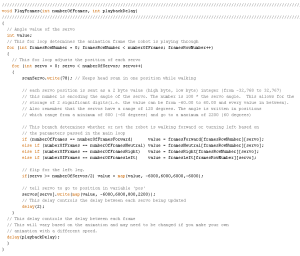
The code used for Spring 2014 used a simpler method for playing the action frames. Rather than use a timing system to determine which frame the robot should be on, the new code uses two loops to run through every element of the action frame array. One loop runs through the elements of each row to update each servo. The second loop moves from row to row to progress the animation. A playbackDelay variable is used to determine the speed of the action progression. The action of moving the servos to their positions is based on the SetServoPositions function from the original code. The rest of the code is similar to the original code.
Reason for the switch:
When creating the animations and testing them out on RobotPoser, there were no significant issues with the playback. However, when attempting to have the microcontroller handle the animation in a standalone code, the robot would start on a frame in the middle of the walking animation, rather than start on the first frame.
This issue became more prominent as more code was added to handle the obstacle avoidance using the ultrasonic sensor, since the delays caused by the use of the ultrasonic sensor affected the timing of the animation. The problem was found when two things happened. The first was that the incorrect leg oved forward at the start of the playback. The second was the effect of the addition of the ultrasonic sensor code and the right turn code on the forward walk layback. After the robot turned right in response to an object 30 cm in front of it, the forward walk would start on the incorrect frame.
With the new program, the robot will always start on the first frame and run through the animation without skipping a frame. The addition of more code has been simplified because of the minimal impact on the animation playbacks, since the playback speed is controlled by a manual delay. In addition, the new code will hopefully be easier to understand at first glance.
Main Code (without Arxterra):
https://github.com/kh0/Spring-2014-ROFIA/blob/master/ROFIACode/MovementCode
Note: The Arduino code exported from RobotPoser does not include the functions that apply the calibrations to the frames of animation.

